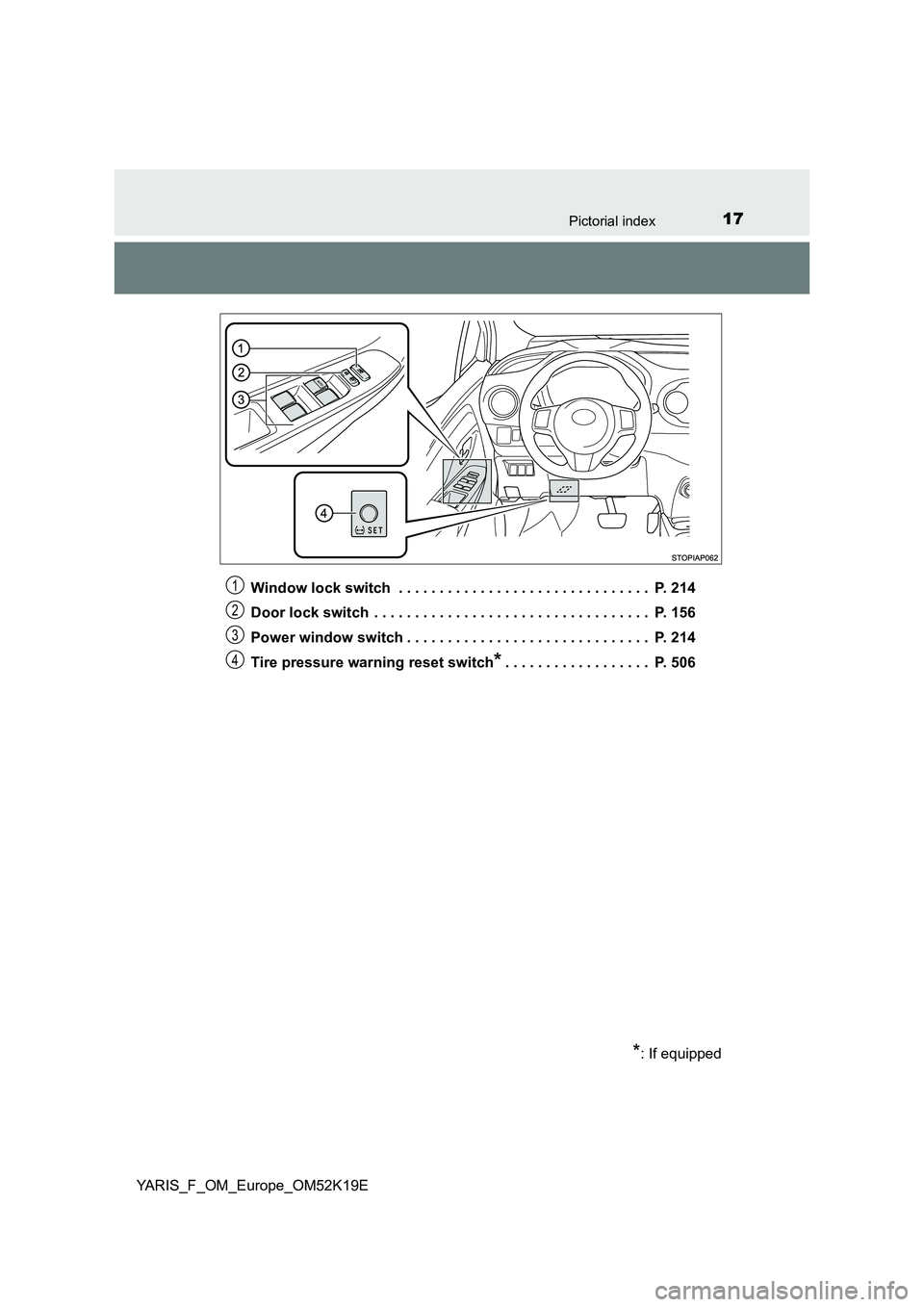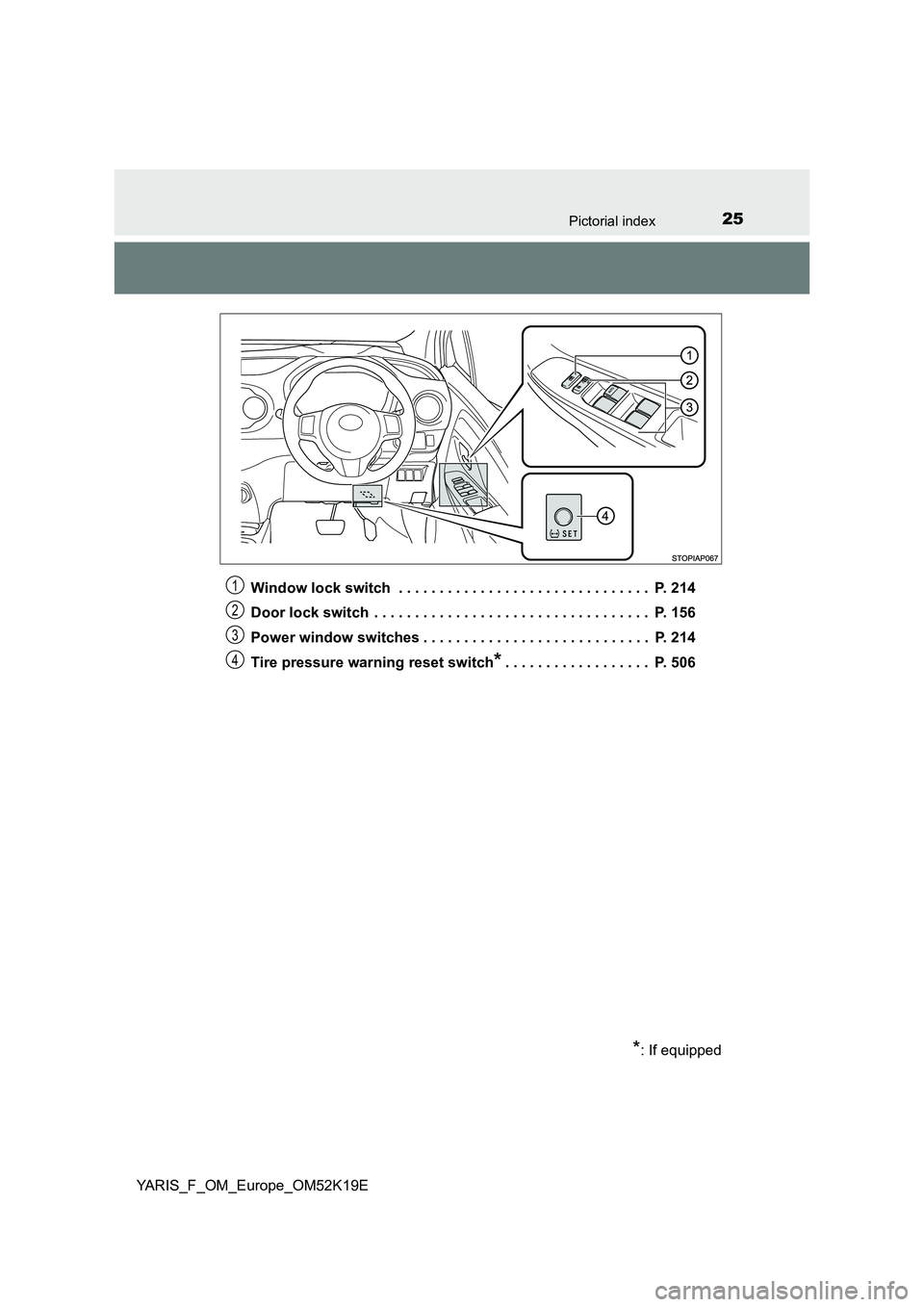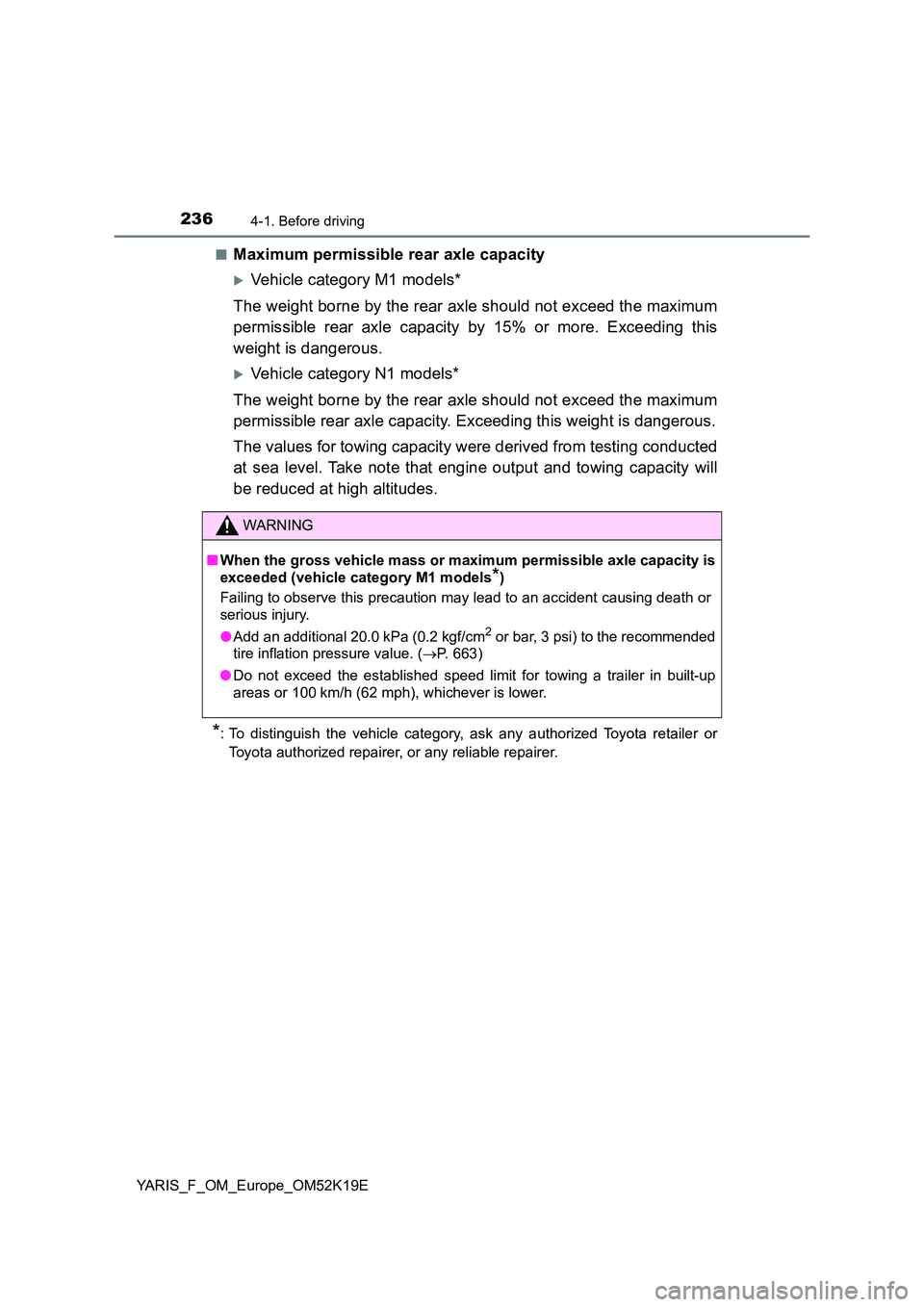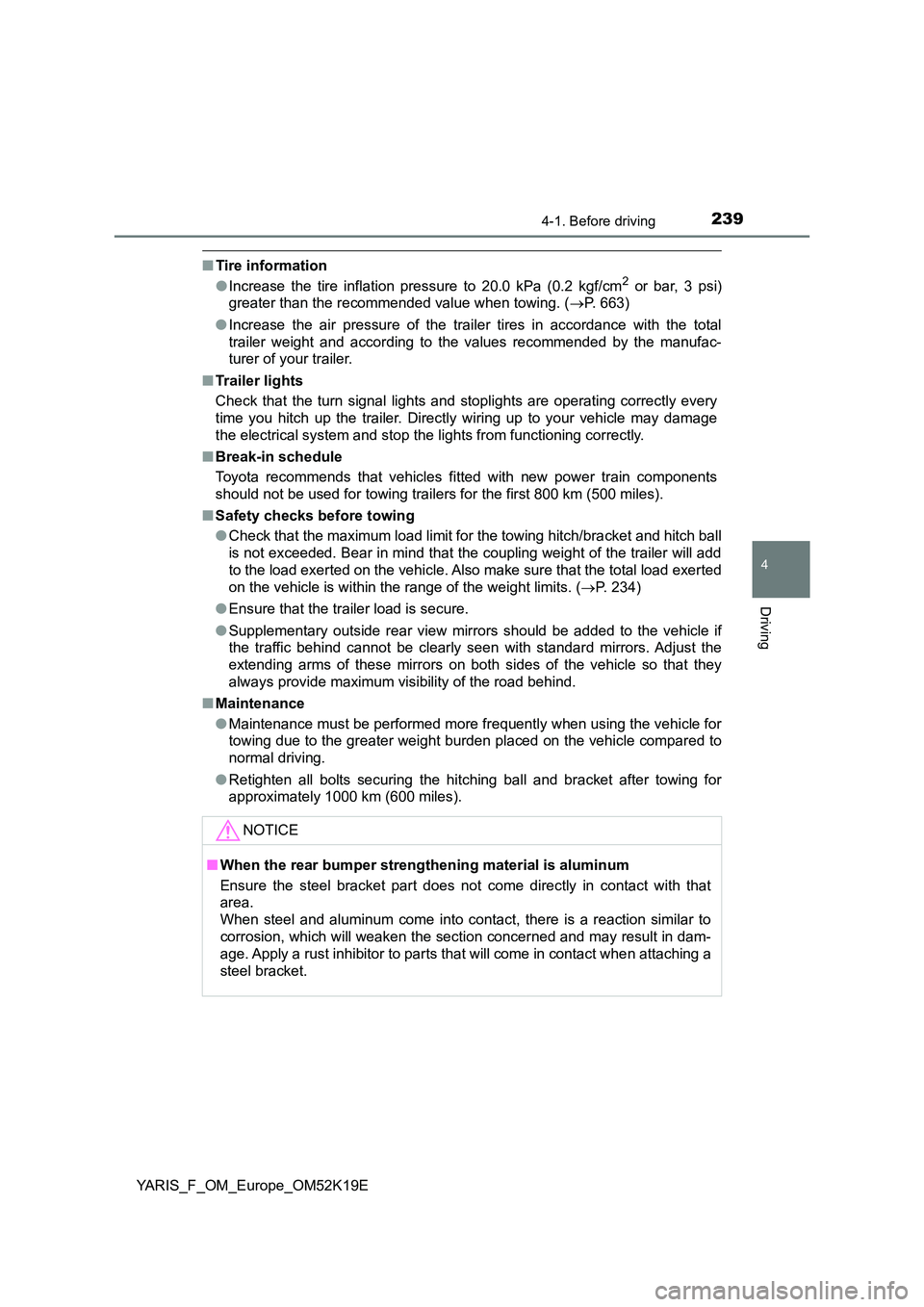2019 TOYOTA YARIS tire pressure
[x] Cancel search: tire pressurePage 6 of 700

TABLE OF CONTENTS6
YARIS_F_OM_Europe_OM52K19E
6-4. Using the other interior
features
Other interior features ........462
• Sun visors ......................462
• Vanity mirrors ................462
• Portable ashtray ............464
• Cigarette lighter .............465
• Power outlet ..................466
• Armrest ..........................467
• Panoramic roof shade ...467
• Assist grips ....................468
7-1. Maintenance and care
Cleaning and protecting
the vehicle exterior ..........470
Cleaning and protecting
the vehicle interior ...........474
7-2. Maintenance
Maintenance
requirements....................477
7-3. Do-it-yourself maintenance
Do-it-yourself service
precautions ......................480
Hood ..................................483
Positioning a floor jack .......485
Engine compartment ......... 487
Tires .................................. 503
Tire inflation pressure........ 523
Wheels .............................. 525
Air conditioning filter .......... 529
Wireless remote control/
electronic key battery ...... 532
Checking and replacing
fuses ............................... 536
Light bulbs ......................... 542
8-1. Essential information
Emergency flashers .......... 564
If your vehicle has to
be stopped in
an emergency ................. 565
8-2. Steps to take in
an emergency
If your vehicle needs to
be towed ......................... 567
If you think something is
wrong .............................. 574
Fuel pump shut off system
(gasoline engine only) ..... 575
7Maintenance and care8When trouble arises
Page 13 of 700

13Pictorial index
YARIS_F_OM_Europe_OM52K19E
Wipers. . . . . . . . . . . . . . . . . . . . . . . . . . . . . . . . . . . . . . . P. 276, 280
Precautions against winter season . . . . . . . . . . . . . . . . . . . . . P. 355
Precautions against car wash . . . . . . . . . . . . . . . . . . . . . . . . . P. 471
Fuel filler door . . . . . . . . . . . . . . . . . . . . . . . . . . . . . . . . . . . . P. 282
Refueling method . . . . . . . . . . . . . . . . . . . . . . . . . . . . . . . . . . P. 282
Fuel type/fuel tank capacity . . . . . . . . . . . . . . . . . . . . . . . . . . . P. 652
Tires . . . . . . . . . . . . . . . . . . . . . . . . . . . . . . . . . . . . . . . . . . . . P. 503
Tire size/inflation pressure . . . . . . . . . . . . . . . . . . . . . . . . . . . . P. 663
Winter tires/tire chain . . . . . . . . . . . . . . . . . . . . . . . . . . . . . . . . P. 357
Checking/rotation/tire pressure warning system*3 . . . . . . . . . P. 503
Coping with flat tires . . . . . . . . . . . . . . . . . . . . . . . . . . . . P. 592, 610
Hood . . . . . . . . . . . . . . . . . . . . . . . . . . . . . . . . . . . . . . . . . . . . P. 483
Opening . . . . . . . . . . . . . . . . . . . . . . . . . . . . . . . . . . . . . . . . . . P. 483
Engine oil . . . . . . . . . . . . . . . . . . . . . . . . . . . . . . . . . . . . . . . . . P. 653
Coping with overheat . . . . . . . . . . . . . . . . . . . . . . . . . . . . . . . . P. 636
Headlights/front position lights/
daytime running lights . . . . . . . . . . . . . . . . . . . . . . . . . . . . . P. 269
Front turn signal lights . . . . . . . . . . . . . . . . . . . . . . . . . . . . . P. 267
Front fog lights*3. . . . . . . . . . . . . . . . . . . . . . . . . . . . . . . . . . P. 274
Side turn signal lights . . . . . . . . . . . . . . . . . . . . . . . . . . . . . . P. 267
Rear turn signal lights. . . . . . . . . . . . . . . . . . . . . . . . . . . . . . P. 267
Back up lights/tail lights (LED type) . . . . . . . . . . . . . . . . . . P. 269
Shifting the shift lever to R. . . . . . . . . . . . . . . . . . . . . . . . P. 255, 263
Stop/tail lights . . . . . . . . . . . . . . . . . . . . . . . . . . . . . . . . . . . . P. 269
Rear fog light . . . . . . . . . . . . . . . . . . . . . . . . . . . . . . . . . . . . . P. 274
License plate lights . . . . . . . . . . . . . . . . . . . . . . . . . . . . . . . . P. 269
4
5
6
7
Light bulbs of the exterior lights for driving
(Replacing method: P. 542, Watts: P. 667)
*1: Vehicles with a smart entry & start system
*2: Vehicles with monochrome display
*3: If equipped
8
9
10
11
12
13
14
15
Page 17 of 700

17Pictorial index
YARIS_F_OM_Europe_OM52K19E
Window lock switch . . . . . . . . . . . . . . . . . . . . . . . . . . . . . . . P. 214
Door lock switch . . . . . . . . . . . . . . . . . . . . . . . . . . . . . . . . . . P. 156
Power window switch . . . . . . . . . . . . . . . . . . . . . . . . . . . . . . P. 214
Tire pressure warning reset switch*. . . . . . . . . . . . . . . . . . P. 506
*: If equipped
1
2
3
4
Page 25 of 700

25Pictorial index
YARIS_F_OM_Europe_OM52K19E
Window lock switch . . . . . . . . . . . . . . . . . . . . . . . . . . . . . . . P. 214
Door lock switch . . . . . . . . . . . . . . . . . . . . . . . . . . . . . . . . . . P. 156
Power window switches . . . . . . . . . . . . . . . . . . . . . . . . . . . . P. 214
Tire pressure warning reset switch*. . . . . . . . . . . . . . . . . . P. 506
*: If equipped
1
2
3
4
Page 109 of 700

1092. Instrument cluster
2
Instrument cluster
YARIS_F_OM_Europe_OM52K19E
*1: These lights turn on when the engine switch is turned to the “ON” position
(vehicles without a smart entry & start system) or IGNITION ON mode
(vehicles with a smart entry & start system) to indicate that a system check
is being performed. They will turn off after the engine is started, or after a
few seconds. There may be a malfunction in a system if a light does not
come on, or if the lights do not turn off. Have the vehicle inspected by any
authorized Toyota retailer or Toyota authorized repairer, or any reliable
repairer.
*2: If equipped
*3: The light flashes in yellow to indicate a malfunction. The light flashes
quickly in green to indicate that the steering lock has not been released.
*4: The light turns on to indicate a malfunction.
*5: The light flashes to indicate a malfunction.
*6: Diesel engine
*7: The light illuminate on the center panel.
*8: The lights turn on with LDA indicator to indicate a malfunction.
*9: Vehicles with monochrome display.
*10: Vehicles with color display.
*11: The light illuminates on the multi-information display.
*2, 3, 9
(Yellow)
Smart entry & start sys-
tem indicator
( P. 579)
*1, 2
Tire pressure warning
light ( P. 580)
*9
Open door warning light
( P. 580)
*1, 10
Master warning light
( P. 581)
Low fuel level warning
light ( P. 580)
*1, 6, 9Low engine oil level
warning light ( P. 581)
Driver’s and front pas-
senger’s seat belt
reminder light ( P. 580)
*1, 6, 9
Engine oil change
reminder light ( P. 581)
*2, 7Rear passenger’s seat
belt reminder lights
( P. 580)
Page 236 of 700

2364-1. Before driving
YARIS_F_OM_Europe_OM52K19E
■Maximum permissible rear axle capacity
Vehicle category M1 models*
The weight borne by the rear axle should not exceed the maximum
permissible rear axle capacity by 15% or more. Exceeding this
weight is dangerous.
Vehicle category N1 models*
The weight borne by the rear axle should not exceed the maximum
permissible rear axle capacity. Exceeding this weight is dangerous.
The values for towing capacity were derived from testing conducted
at sea level. Take note that engine output and towing capacity will
be reduced at high altitudes.
*: To distinguish the vehicle category, ask any authorized Toyota retailer or
Toyota authorized repairer, or any reliable repairer.
WARNING
■ When the gross vehicle mass or maximum permissible axle capacity is
exceeded (vehicle category M1 models*)
Failing to observe this precaution may lead to an accident causing death or
serious injury.
● Add an additional 20.0 kPa (0.2 kgf/cm2 or bar, 3 psi) to the recommended
tire inflation pressure value. ( P. 663)
● Do not exceed the established speed limit for towing a trailer in built-up
areas or 100 km/h (62 mph), whichever is lower.
Page 239 of 700

2394-1. Before driving
4
Driving
YARIS_F_OM_Europe_OM52K19E
■Tire information
● Increase the tire inflation pressure to 20.0 kPa (0.2 kgf/cm2 or bar, 3 psi)
greater than the recommended value when towing. ( P. 663)
● Increase the air pressure of the trailer tires in accordance with the total
trailer weight and according to the values recommended by the manufac-
turer of your trailer.
■ Tr a i l e r l i g h ts
Check that the turn signal lights and stoplights are operating correctly every
time you hitch up the trailer. Direct ly wiring up to your vehicle may damage
the electrical system and stop the lights from functioning correctly.
■ Break-in schedule
Toyota recommends that vehicles fitted with new power train components
should not be used for towing trailers for the first 800 km (500 miles).
■ Safety checks before towing
● Check that the maximum load limit for the towing hitch/bracket and hitch ball
is not exceeded. Bear in mind that the coupling weight of the trailer will add
to the load exerted on the vehicle. Also make sure that the total load exerted
on the vehicle is within the range of the weight limits. ( P. 234)
● Ensure that the trailer load is secure.
● Supplementary outside rear view mirrors should be added to the vehicle if
the traffic behind cannot be clearly seen with standard mirrors. Adjust the
extending arms of these mirrors on both sides of the vehicle so that they
always provide maximum visibility of the road behind.
■ Maintenance
● Maintenance must be performed more frequently when using the vehicle for
towing due to the greater weight burden placed on the vehicle compared to
normal driving.
● Retighten all bolts securing the hitching ball and bracket after towing for
approximately 1000 km (600 miles).
NOTICE
■ When the rear bumper strengthening material is aluminum
Ensure the steel bracket part does not come directly in contact with that
area.
When steel and aluminum come into contact, there is a reaction similar to
corrosion, which will weaken the section concerned and may result in dam-
age. Apply a rust inhibitor to parts that will come in contact when attaching a
steel bracket.
Page 307 of 700

3074-5. Toyota Safety Sense
4
Driving
YARIS_F_OM_Europe_OM52K19E
• If the wheels are misaligned
• If a wiper blade is blocking the front sensor • The vehicle is wobbling.• The vehicle is being driven at extremely high speeds.
• When driving on roads with sharp bends or uneven surfaces • When a preceding vehicle is a poor reflector of laser
● In some situations such as the following, sufficient braking force may not be
obtained, preventing the system from performing properly:
• If the braking functions cannot operate to their full extent, such as when the brake parts are extremely cold, extremely hot, or wet• If the vehicle is not properly maintained (brakes or tires are excessively worn,
improper tire inflation pressure, etc.) • When the vehicle is being driven on a gravel road or other slippery surface
• If your vehicle is skidding
• When the front part of the vehicle is
raised or lowered
• When the sensor is misaligned due to
a strong impact being applied to the
sensor, etc.